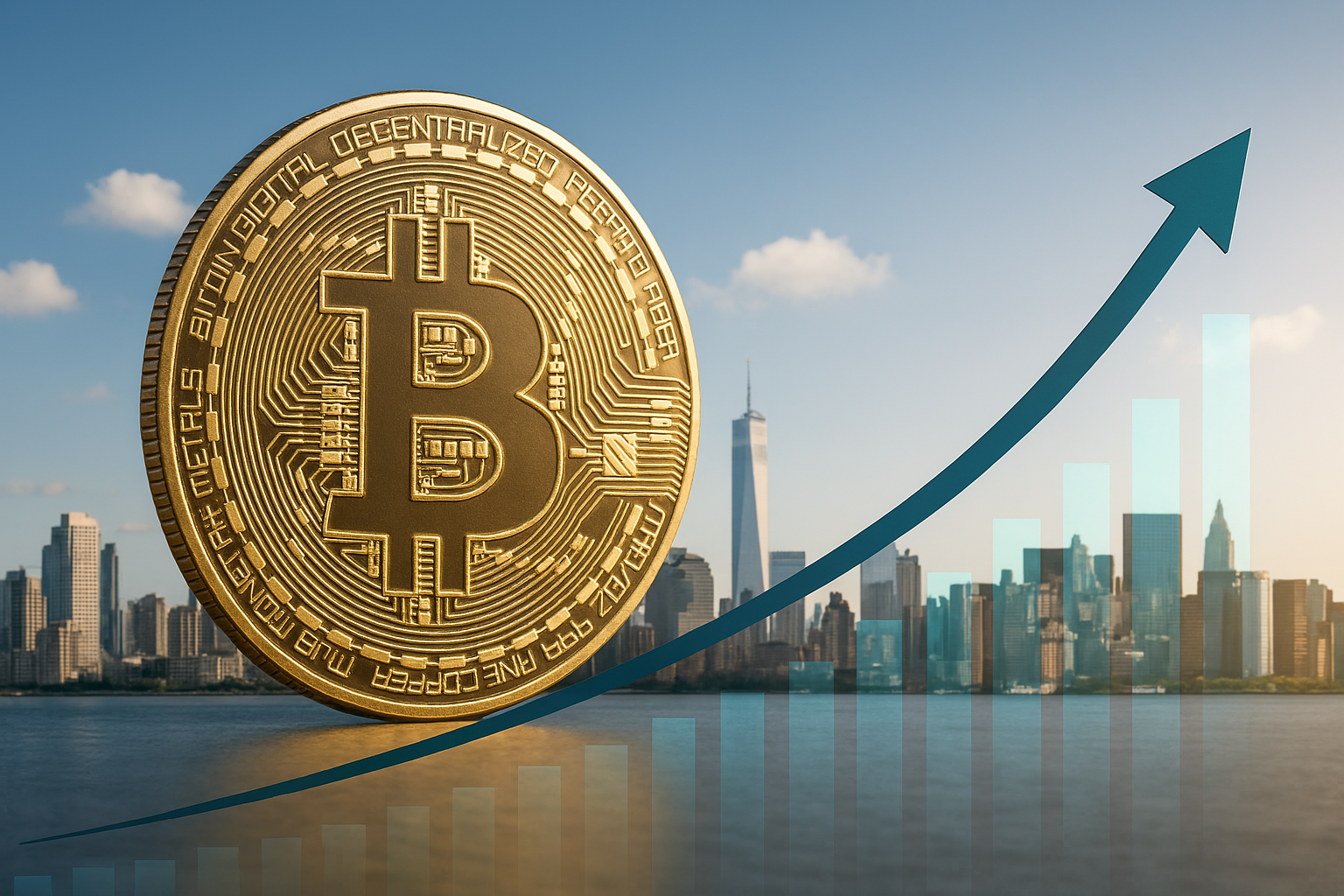Bitcoin From Rebellion To Recognition
What started as an anonymous whitepaper during a financial crisis has grown into a global movement, a digital asset class, and for some—legal tender. Whether you’re curious about crypto or strategizing your next investment move, understanding Bitcoin’s evolution is key to navigating today’s economic landscape.
Key Points
- Bitcoin launched in 2009 as a decentralized digital currency to bypass traditional banking systems.
- It has a maximum supply of 21 million coins, creating digital scarcity that supports long-term value growth.
- Bitcoin adoption has surged—from early enthusiasts to legal tender status in El Salvador.
- The Bitcoin halving cycle reduces miner rewards every 4 years, limiting new supply and historically boosting prices.
- The U.S. is formalizing crypto through SEC regulation and new legislation, increasing market confidence.
- Bitcoin ETFs now offer traditional investors exposure without needing to manage wallets or private keys.
- Mining plays a crucial role in securing the blockchain, and scarcity mechanisms are designed to mimic digital gold.
Table of Contents
- Key Points
- A Currency Born from Crisis
- Early Adoption and the Rise of Digital Assets
- Legal Tender in El Salvador – A Global First
- U.S. Regulation & The Role of the SEC
- Bitcoin Mining and the Power of Scarcity
- Bitcoin ETFs – A Game Changer for Traditional Investors
- Institutional Adoption and the Future of Bitcoin
- Bitcoin From Rebellion To Recognition
- Frequently Asked Questions About Bitcoin
- Ready to Take Control of Your Financial Future?
- Related Posts
A Currency Born from Crisis
Bitcoin emerged in 2009, shortly after the 2008 financial collapse. An anonymous developer—or group—using the pseudonym Satoshi Nakamoto released a whitepaper titled Bitcoin: A Peer-to-Peer Electronic Cash System. The goal? To create a decentralized currency, free from government control and central banks, where trust was built into the code and not reliant on third parties.
At the time, it was a radical idea: money not issued by a nation-state, built on a technology (blockchain) that no one had ever used in this way before. But for early adopters and digital libertarians, it was the start of a financial revolution.
Early Adoption and the Rise of Digital Assets
In its infancy, Bitcoin had little real-world value. In fact, in 2010, a programmer famously paid 10,000 BTC for two pizzas—a transaction now celebrated annually as “Bitcoin Pizza Day.”
As the years progressed, Bitcoin began to gain traction among developers, crypto enthusiasts, and eventually, speculative investors. The 2017 bull run saw prices climb to nearly $20,000, bringing Bitcoin into the public eye. Then, after a steep correction, the next major rally in 2020-2021 pushed it beyond $60,000, spurred by increased institutional interest and public awareness.
Legal Tender in El Salvador – A Global First
In 2021, El Salvador became the first country in the world to adopt Bitcoin as legal tender. Citizens can now pay taxes and shop using Bitcoin, and businesses are required to accept it (though compliance remains varied).
The government even issued its own Chivo wallet app and installed Bitcoin ATMs throughout the country. While controversial, this bold move placed Bitcoin on the geopolitical stage and opened the door for discussions in other nations—especially those with volatile currencies or limited access to global banking.
U.S. Regulation & The Role of the SEC
While Bitcoin was growing globally, U.S. regulators began stepping in to bring order and clarity to the digital asset space. The Securities and Exchange Commission (SEC) and Commodity Futures Trading Commission (CFTC) began distinguishing between cryptocurrencies that should be treated as securities (like stocks) and those like Bitcoin, which were often categorized as commodities.
In 2024, the U.S. began formalizing regulations around crypto exchanges, digital wallets, anti-money laundering (AML) practices, and investor protections. This helped remove a layer of uncertainty that had long plagued crypto investors.
Bitcoin Mining and the Power of Scarcity
Unlike traditional currencies that can be printed at will, Bitcoin operates on a finite supply model, which is one of the reasons it’s often referred to as digital gold.
Only 21 million Bitcoin will ever exist—a hard cap coded into the protocol from the beginning. This scarcity is what makes Bitcoin deflationary by design.
So, how are Bitcoins created?
Through a process called mining. Bitcoin mining is the act of using powerful computers to solve complex mathematical puzzles that validate and secure transactions on the blockchain. In return for their work, miners are rewarded with newly created Bitcoin.
But here’s where it gets even more strategic:
Every four years (roughly every 210,000 blocks), a phenomenon known as the Bitcoin Halving takes place. This event cuts the reward given to miners in half.
When Bitcoin launched in 2009, miners received 50 BTC per block. After several halvings, that reward is now just 3.125 BTC as of April 2024.
What does this mean for investors?
Each halving reduces the rate of new Bitcoin entering circulation, tightening supply. If demand remains the same—or increases—the price typically rises over time. Historically, Bitcoin has seen significant bull runs in the 12–18 months following a halving, driven by this engineered scarcity.
It’s a clever mechanism that mimics gold’s limited availability while incentivizing miners to maintain the network’s security.
Bitcoin ETFs – A Game Changer for Traditional Investors
Perhaps one of the biggest turning points in Bitcoin’s journey came with the approval of Bitcoin ETFs (Exchange-Traded Funds).
These investment vehicles allow people to buy into Bitcoin exposure without holding it directly. Instead of managing wallets and private keys, investors can simply buy shares through traditional brokerage accounts. ETFs like BlackRock’s iShares Bitcoin Trust (IBIT) and Fidelity’s Wise Origin Bitcoin Fund have made crypto accessible to retirement accounts, institutions, and risk-managed portfolios.
This mainstream adoption signals that Bitcoin is no longer a fringe investment—it’s becoming a serious asset class in diversified portfolios.
Institutional Adoption and the Future of Bitcoin
From Tesla briefly accepting Bitcoin for cars, to financial giants like Fidelity, BlackRock, and JPMorgan offering crypto products, institutional adoption is growing. While the volatility remains, the infrastructure is maturing—futures markets, regulated exchanges, and custodial services now support billions in Bitcoin-based assets.
Even governments and central banks are beginning to take notes. While not all embrace Bitcoin, many are exploring Central Bank Digital Currencies (CBDCs)—their own blockchain-based alternatives.
Bitcoin From Rebellion To Recognition
Bitcoin’s story is far from over. What started as a digital rebellion is becoming a regulated, globally recognized financial instrument. From early adopters trading pizzas to billion-dollar ETFs and legal tender in sovereign nations, the transformation is remarkable.
Whether you’re in it for the tech, the freedom, or the investment potential, Bitcoin has proven that decentralized innovation can no longer be ignored.
Frequently Asked Questions About Bitcoin
What is Bitcoin, in simple terms?
Bitcoin is a digital currency that allows people to send and receive money over the internet without needing a bank. It’s decentralized, which means no government or company controls it. Transactions are recorded on a public ledger called the blockchain.
How many Bitcoins are there?
The total supply of Bitcoin is capped at 21 million coins. This limited supply helps create scarcity, much like gold, which is one of the reasons people believe its value can grow over time.
What is Bitcoin mining?
Mining is the process of verifying Bitcoin transactions and adding them to the blockchain. Miners use powerful computers to solve complex problems, and in return, they earn new Bitcoin as a reward. This is also how new Bitcoin is created—until the cap of 21 million is reached.
What is the Bitcoin halving?
Every four years, the reward miners receive is cut in half. This is called a halving event. It slows down the rate at which new Bitcoin is created, making it more scarce. Historically, prices have often increased after a halving due to reduced supply.
Is Bitcoin legal?
Yes, Bitcoin is legal in most countries, but how it’s regulated varies. Some countries like El Salvador have adopted it as legal tender, while others have strict regulations or outright bans. In the U.S., it’s legal and regulated through frameworks like those established by the SEC and CFTC.
Do I need to buy a full Bitcoin to invest?
Not at all! You can buy a fraction of a Bitcoin. It’s divisible down to eight decimal places—the smallest unit is called a Satoshi, or 0.00000001 BTC.
What are Bitcoin ETFs?
Bitcoin ETFs (Exchange-Traded Funds) let investors buy into Bitcoin through traditional stock exchanges without having to manage wallets or private keys. ETFs track the price of Bitcoin and are great for those who want exposure without the technical setup.
Is Bitcoin safe?
Bitcoin’s network is very secure, but like any investment, there are risks. It’s important to store your Bitcoin in a secure wallet and never share your private keys. Prices can be volatile, so do your research before investing.
Can I use Bitcoin to buy things?
Yes! Many online platforms and some physical stores accept Bitcoin as payment. You can also use Bitcoin debit cards that convert it to local currency at the point of sale.
Ready to Take Control of Your Financial Future?
Bitcoin is just the beginning. Inside the Zero to Millionaire Membership, you’ll learn how to build lasting wealth through strategic investing—including crypto, shares, property, and more.
Whether you’re just getting started or want to strengthen your portfolio with real-world, proven strategies, this membership is designed to guide you step by step.
Join Zero to Millionaire today and start investing with confidence:
Smart entrepreneurs build lasting wealth—don’t get left behind.
Related Posts

Karen Newton is a Business and Wealth Strategist, 3x International Bestselling Author, and founder of Karen Newton International. She combines practical experience with AI-Powered Entrepreneurship to help smart entrepreneurs build online income, invest strategically, and create long-term wealth through business growth, investments and joint ventures.










